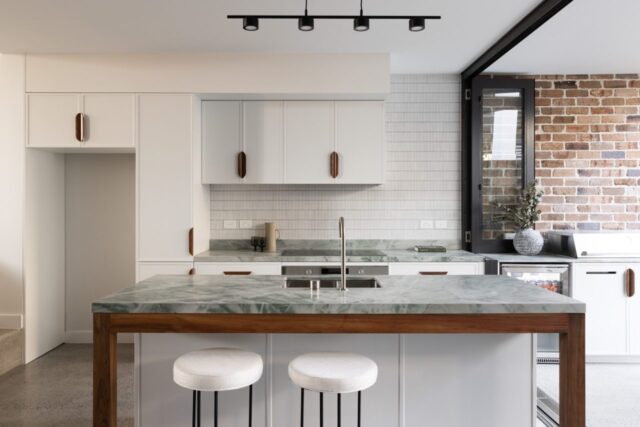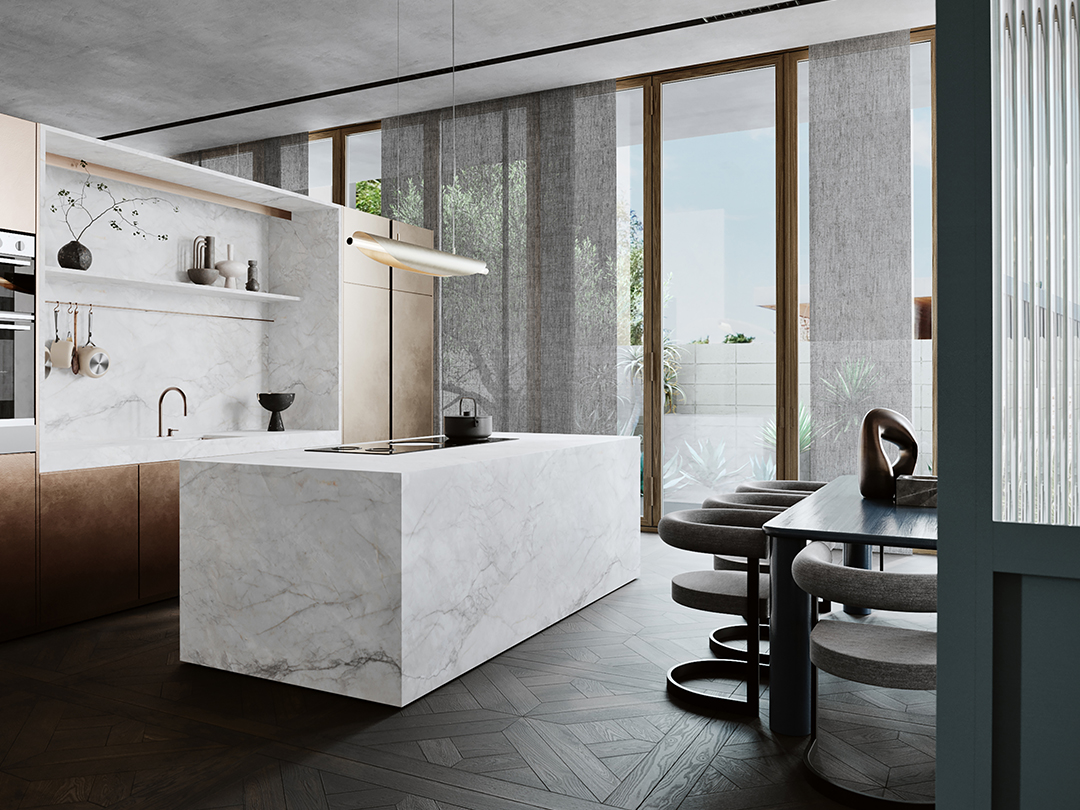Sponsored by Smartstone, Caesarstone and CAV’ART Designer Stone
It’s been almost five months since the Government banned the use, supply and manufacture of engineered stone due to concerns about the health risk to those working with it. So, what now? Many consumers are still a little confused about what’s allowed and many brands have come up with new and safe low and no-silica alternatives. We asked Caesarstone and Smartstone to share their latest offerings, as well as natural stone supplier CAV’ART Designer Stone.

SMARTSTONE
In welcome news for stonemasons and consumers alike, Smartstone has pivoted with the recent release of a viable engineered stone alternative: the Sintered Collection. This comprehensive, government-approved surface solution continues Smartstone’s 20-plus years of innovation as a leading distributor of stone-inspired surfaces.
New stone alternative
The new Sintered Collection elevates traditional porcelain surfaces to an entirely new level of aesthetics and performance – while, of course, being fully compliant with new government legislation. The Sintered Collection differs from engineered stone in its manufacture and composition, using a ‘sintering’ process that comprises only natural raw materials and uses no resins or adhesives. Sintering combines advanced stone manufacturing technology with natural fusion techniques to create an ultra-compact, non-porous stone surface with a refined aesthetic.


Natural stone style. Superior durability
With the Sintered Collection, Smartstone replicated the world’s most beautiful marble and natural stones, from marble and granite and even concretes, with impeccable design accuracy and sintered stone durability.
Marble is considered a soft stone registering a rating of 3-to-4 in Mohs hardness scale while sintered Collection has a rating of 7 on the hardness scale (diamond being the hardest mineral at 10). And while marble and natural stone are porous and require regular sealing, sintered stone is non-porous with almost nil absorption level and highly resistant to scratching.


Due to non-porosity, Smartstone sintered surfaces are deemed antibacterial and suitable for food preparation areas as well as wet areas.
Hardwearing performance. Indoors and out.
The new Smartstone Sintered Collection is an extremely durable surface material. It is impervious to stains, chips, scratches, household chemicals and extreme heat which makes it a great choice for fireplaces, outdoor kitchens and barbecues. Unlike engineered stone, the sintered surface’s UV-stability and weather-proof capabilities extend its usage to the great outdoors, as well as interiors. This amps up its versatility for use in a vast array of residential and commercial applications, from benchtops and bathroom vanities, to fireplaces, walls and furniture.
Sophisticated aesthetic with through-body veining
Advanced print technology extends beneath the surface to the colour-matched body biscuit. Veined surfaces in the range feature through-body veining for next level authenticity. With through-body veining, even 20mm pencil round or arris profiles can achieve an authentic stone look by showcasing veins on exposed edges without any need for mitring.
In achieving a more natural texture, Sintered Collection surfaces come in either Matt or Suede finishes and can be fabricated in several edge profiles.
Trusted quality. Affordable luxury.
Not only is the new collection compliant with Australian government legislation and has provided a genuine alternative to engineered stone, it also meets the increasing demand for natural stone by offering a more cost-effective option without sacrificing the natural look of marble and stone. Sintered stone slabs are produced in a matter of hours, whereas natural stones, such as marble and granite, take thousands of years to form.
While representing an exciting product evolution beyond its previous engineered surface collection, the new Sintered Collection maintains the many trusted qualities for which Smartstone has long been renowned. It continues Smartstone affordability, with the collection housed in three price points, from Pure through to Classic and Deluxe. Smartstone’s large slabs (3200mm x 1600mm x 20mm) deliver economy while enhancing design freedom.
CAESARSTONE
The end of an era in engineered stone brought with it the exciting prospect of brand new surfaces for the home, ones that are sustainable and free of crystalline silica.
Caesarstone launched its first ever collection of Porcelain in 2022, before launching its revolutionary new sustainable, crystalline silica-free mineral surfaces in early 2024.


Caesarstone® Mineral™ is a feat of ingenuity, retaining the visual aesthetics as well as the unrivalled performance of its original world-first engineered stone collection.
The Mineral collection of 33 designs comprises a unique mix of minerals and contains a minimum of 80% recycled materials (such as glass). These surfaces contain no crystalline silica. The gamechanger is the fact that this Mineral range looks and performs like the surfaces it has replaced – exceptional resistance to heat, stains and scratches – while being the only surface of its kind to carry a lifetime warranty.
As a pioneer and leader of the global benchtop industry for more than 35 years, Caesarstone is once again at the forefront of technological innovation, releasing a range of Mineral Crystalline Silica-Free surfaces in the first half of this year (2024), with more being added over coming months.
With Caesarstone® Mineral™ Crystalline Silica-Free, the brand has retained all of the most popular colours and designs of its original engineered stone collection, such as the marble-inspired Calacatta Nuvo, Empira White and Statuario Maximus plus concrete designs such as Fresh Concrete and Raw Concrete.
The new Mineral Crystalline Silica-Free collection is produced in Grande size slabs (3240 x 1640 x 20mm) to maximise the expanse of joint-free surface achievable.
Each Mineral Crystalline Silica-Free surface is produced with the utmost attention to sustainable practices. The surfaces, which will never require sealing, are both non-porous and non-toxic, with extensive independent testing certifying the absence of crystalline silica and VOCs (Volatile Organic Compounds). Caesarstone benchtops are guaranteed to be safe to use in the home, including when the product is being installed. These benchtops also pose no risk during the fabrication process, provided the necessary safety measures are adhered to.
In addition, consumers can select from Caesarstone’s collection of 22 Porcelain designs that are suitable for both indoor and outdoor installations, enabling an uninterrupted flow of aesthetics from inside to out.


Caesarstone® Porcelain™ takes inspiration from natural stones such as marble and limestone – and even concrete – but has a level of beauty and performance all of its own. While being more affordable than its natural counterpart, it is also completely non-porous and stain-resistant (with no need for sealing) and will therefore retain its original beauty far longer (it also carries a lifetime warranty).
Crafted from natural raw ingredients such as clay, feldspar and natural oxides, Caesarstone Porcelain’s production process adheres to the brand’s ‘green waste’ reuse process, whereby up to 20% of its contents are the waste from the first stage of production and 100% of all water is recycled.
Available in a 12mm profile (with some designs also available in 20mm), in a range of finishes from silk and stone to honed and ultra rough, each slab is a full 1600 x 3200mm, making the creation of sweeping expanses of joint-free surfaces a welcome reality.
CAV’ART DESIGNER STONE
CAV’ART Designer Stone boss Nathan Karpenko says the recent ban has seen an uptick not only in sales but also education around natural stone. He thinks there’s a place for both, with some clients choosing to use natural in certain rooms or applications and engineered alternatives elsewhere; it’s no longer an all or nothing approach.
“There’s definitely been more interest in and education around natural stone since the ban, and even in the run-up to it, which is part of what gave me the confidence to start the business. There’s definitely far more knowledge out there by the end user. There’s also more availability of products like quartzite, granite and dolomite as well as your marbles.


“I think there’s definitely a place for both these new engineered products, sintered stone and porcelain and natural stone. You might see a customer choose natural for the island bench and behind the cooktop but they’re using engineered in the butler’s pantry which is the real workhorse. It’s no longer a case of either one or the other.
“In the early 2000s, Australia was one of the biggest users per capita for engineered stone and their marketing was really great, convincing people it was invincible, rather than highly stain resistant. I think in the last five years or so though, people have become less fearful or using natural stone and more aware of the durability of things like Taj Mahal quartzite, which is probably about every second enquiry for us at the moment! Granite is also available in some really nice vibrant colours now. It is not the daggy product it may have been seen as in the past.


“And of course from an aesthetic perspective you just can’t compare the beauty of natural stone with something mass produced and each slab is completely unique and one off. We might have one block of Super White, which is still really popular, and that will have 60 slabs which when you look at them, are similar but different.
“Choosing a slab of natural stone is such an emotional process for this reason. Often, people ask us which one they should pick and we tell them it should be personal and the one that resonates with them. Nine times out of 10, they’ll come back to the one they went for first. We love spending that time with customers and helping them choose.”


Caesarstone branches out into new porcelain surface range
Caesarstone have unveiled their first ever porcelain collection. Leveraging their 35-year legacy of craftsmanship and innovation – they introduced the first quartz surface in 1987 – they’re now attempting to master the porcelain surface for both interior and exterior use. The three pillars of this new advanced technology comprise a fortified frame (providing an extremely hard surface that is exceptionally resistant to scratches, pressure and rupture), a high heat structure, that will withstand extremely high temperatures (hot objects can be placed directly on it), and great design in the striking colour schemes, bolder veins, palpable textures, and magnified patterns. The…


CAV’ART: A stone business with heart, built on relationships
Sponsored by CAV’ART Designer Stone You only have to look at the countless beautiful photographs of kitchens and bathrooms using CAV’ART Designer Stone’s products to know they sell an incredible natural stone range but owning a business and dealing with the industry and customers is about a lot more for Nathan Karpenko. Starting his career in hospitality, where he worked in five-star hotels and learned everything about problem-solving, people skills and customer service, he later went to work for one of the biggest stone suppliers in the business. But a health scare made him reassess the trajectory his life was…





